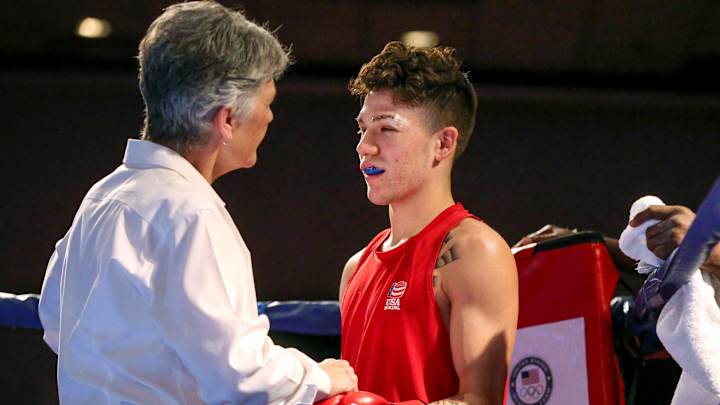With no headgear, US Olympic boxers are struggling with cuts

RENO, Nev. (AP) Antonio Vargas never had a cut in his boxing life until blood trickled down his forehead Wednesday during his most important bout.
The touted flyweight fought through the surprise and pain, but his Olympic dreams were imperiled when he lost a split decision at the U.S. team trials.
''It happened so fast,'' Vargas said. ''It was just a clash of heads. I had that fight, man.''
Vargas didn't blame his loss on the blood, but facial cuts are a growing problem worldwide for Olympic-style boxers fighting for places in Rio de Janeiro at the first Olympics since the International Boxing Association (AIBA) decided male boxers will no longer wear protective headgear.
Seven fighters developed significant cuts during the first three days of the U.S. Olympic trials in Reno this week, including heavyweight favorite Cam F. Awesome and Vargas, the Pan Am Games champion who might be the Americans' best chance to end their 12-year gold medal drought. They both fought on, but three other boxers were cut badly enough to force them out of the tournament.
Mark Dawson was done after he needed 18 stitches in his forehead to seal a grotesque cut, also the first of his career. Even Chris Ousley's Olympic dream died because his opponent, Carlos Monroe, was cut down to the skull and couldn't continue, yet still won their bout on the scorecards.
The problems aren't confined to the U.S., with serious cuts reported from tournaments around the world since the 2013 rule change. AIBA reportedly reassessed its headgear decision during the 2014 Commonwealth Games in Glasgow when Australian boxer Daniel Lewis was cut too badly to continue, but quickly confirmed the plan would move forward to Rio.
Even AIBA's detractors realize the absence of headgear has made Olympic boxing more television-friendly. While AIBA acknowledges the danger of cuts, it claims the change was made because concussions will decrease without the heavy protective padding, although many American coaches and fighters chuckle at the science used to justify the decision.
''I don't like it, and I don't think it's necessary,'' said Virgil Hunter, the respected veteran trainer behind Olympic gold medalist Andre Ward's career. ''Because what does it really say about the sport? You're subjecting a kid to trauma for nothing. It's one thing to get cut, and you get a million-dollar check when you get out of there. It's another thing to get cut, and you get a trophy or a handshake.''
Boxers have worn headgear in every Olympics since the 1984 Los Angeles Games, and women still wear it. The proliferation of cuts is fueling complaints throughout the sport from athletes and trainers who believe head guards are the only practical way to compete in an Olympic-style, multi-fight tournament.
WBO 140-pound champion Terence Crawford was an accomplished amateur boxer, but the unbeaten pro star wouldn't be interested in the current version of the sport.
''These kids are getting cut up and not getting paid for it, and it's potentially coming back to haunt them in their pro career,'' said Crawford, who traveled to Reno to support friends from Nebraska. ''I've already seen four cuts in one day, and then you ask them to get stitched up and go fight tomorrow.''
In a sport long dominated by tedious complaints about judging, AIBA's move from computer scoring to a traditional 10-point judging system has drawn widespread praise.
Instead, American fighters won't be surprised if cuts are the biggest story out of Rio.
Cuts usually result from two heads banging together. That's a frequent occurrence in pro boxing, but Olympic-style fighters don't have the luxury of months off to heal. They usually must fight the next day or be disqualified.
''If they're going to make us fight without headgear, there should be some kind of payment,'' said Ousley, who plans to turn pro. ''They're making us take drug tests, do all this other stuff, and we're basically fighting for charity. We're volunteering. I can't stay in amateur boxing.''
AIBA has encouraged fighters to wear cut-reducing creams, and it has started an initiative called HeadsUp! to encourage fighters to compete with fewer inadvertent head-butts.
USA Boxing officials hold a precarious position between their amateur fighters and AIBA, which has eliminated the word ''amateur'' from even its name while creating several professional ventures for its fighters. USA Boxing doesn't want fighters sabotaged by cuts, but also wants to support the international governing body in a notoriously political sport.
Headgear decisions in domestic tournaments could be taken out of the hands of USA Boxing soon. Various state athletic commissions already have expressed concern about headgear-free boxing by amateurs, with some refusing to allow it.
''I think AIBA wants to work with us as well,'' said Mike Martino, USA Boxing's executive director. ''They realize this could be a public relations nightmare if it continues.''
Headgear-free fighting also has American supporters.
Awesome, a veteran amateur and national champion, was cut along his left eyebrow in his opening bout in Reno. He strung together three straight wins to reach the brink of an Olympic team berth.
''It's making boxing more exciting,'' Awesome said. ''If I tell people I box before, they say, `Oh, you wear the helmet? That's not real boxing.' Now, people are more excited about the sport. ... It's risk for reward. Our sport is not very exciting to Americans. We're sacrificing our safety for the good of the sport.
''It hurts sometimes, but I want boxing to thrive.''
